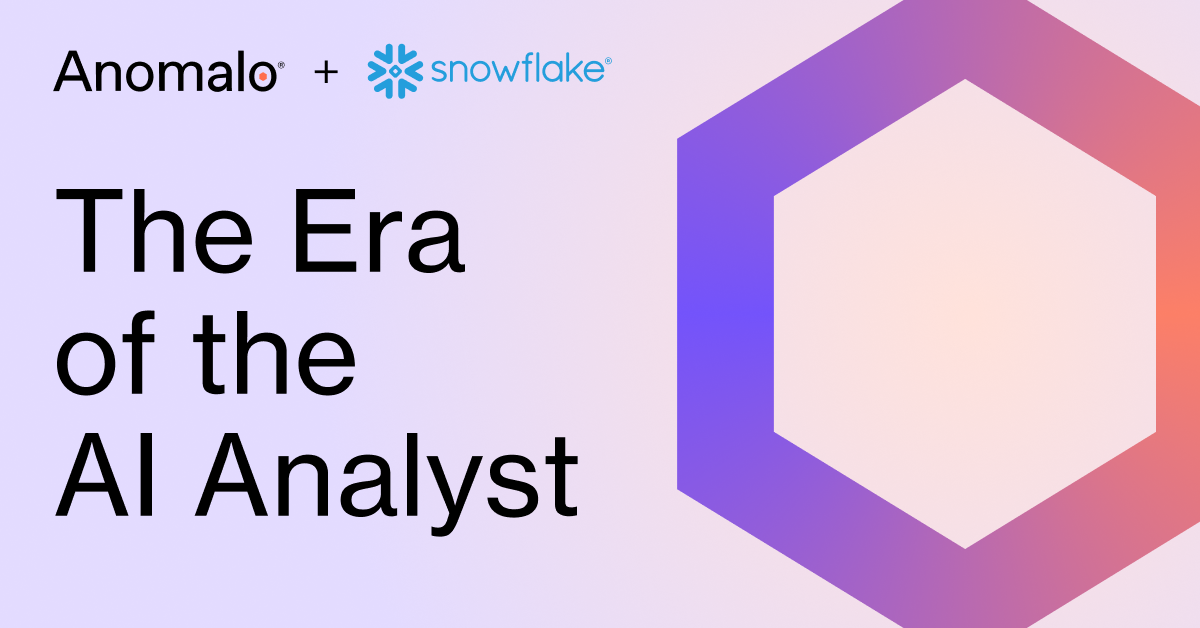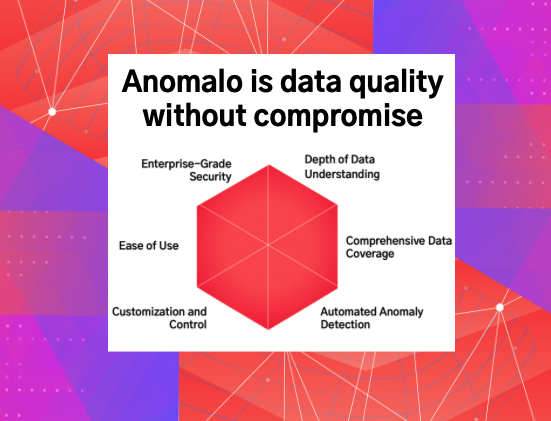Introduction to Data Ingestion: A Comprehensive Guide
February 21, 2024

What is Data Ingestion?
Data ingestion is a critical component of the data lifecycle. It refers to the process of importing, transferring, loading, and processing data from various sources into a system where it can be stored, analyzed, and utilized by an organization. Good data ingestion pipelines are vital for organizations to maintain high data quality — including accuracy, completeness, and timeliness. Data quality ultimately underpins the insights and value derived from the data itself, whether you’re using data for machine learning/generative AI, BI and analytics, or to power new products and features.
The landscape of data ingestion is constantly evolving, becoming more complex as technologies change. With an explosion of data sources and volumes in recent years, ingestion tools must now accommodate real-time streaming data, large-scale batch processing, and complex data integration scenarios.
This comprehensive guide covers everything from the basics of the data ingestion process, to emerging trends in the space. You’ll learn best practices that can help you ingest data at scale and from many different data sources while maintaining high data quality, to ensure that you can feel confident about the data powering your business.
Foundations of Data Ingestion
The data ingestion process, explained
The data ingestion process is fundamental to managing and leveraging an organization’s data assets effectively. Typically, this process involves three key stages: Extraction, Transformation, and Loading (ETL). Loading can also occur before transformation in the flow, in which case it would be ELT.
In extraction, data is collected from various sources, which may include databases, files, streaming sources, or external APIs. This phase is critical as it sets the stage for how well the data can be used down the line.
Next is transformation, where the ingested data is cleansed, reformatted, or enriched to ensure consistency and compatibility with the storage system (e.g., data warehouse or lakehouse). This step is vital for converting raw data into a format that is more suitable for downstream consumption. The final stage, loading, involves moving the transformed data into storage, where it will be made available to other business users/consumers.
The importance of proper data ingestion
Proper data ingestion preserves data quality, which is essential for ensuring you have useful, trustworthy data entering your data warehouse. Effective ingestion processes ensure that the data collected is accurate, consistent, and free of errors. This is essential for reliable analytics, accurate models, products that work as expected, and informed decision-making.
Along with accuracy, another aspect of data quality is timeliness and completeness. Good data ingestion pipelines operate efficiently at scale to fully deliver data at a regular, expected cadence. Data is only really useful if it’s delivered on time, allowing businesses to react quickly and make decisions that are based on the most up-to-date information.
Finally, data accessibility is a critical outcome of proper data ingestion. Along with the consolidating data into one place, ingestion also performs transformations that, when done correctly, ensures that data is cleansed and in a format that others can use. Teams that have good data ingestion processes are empowered to work with data and derive insights independently.
Components of Data Ingestion
Source Systems
Source systems are the starting point of the data ingestion process, and they vary widely depending on the nature and scale of the data. Common source systems include:
- Databases, which can range from on-premises transactional data stores to cloud data warehouses and data lakes
- APIs (Application Programming Interfaces), a key source for real-time data ingestion from services and applications
- File systems, particularly for batch processing of data stored in formats like CSV, JSON, or XML
Understanding the nature and capabilities of your source systems, along with any data contracts related to availability, uptime, formatting expectations, etc. is crucial in designing an effective data ingestion pipeline.
Data Storage
Once data is ingested, it needs to be stored in a format and location that facilitates easy access and processing. Data warehouses and data lakes are two primary data storage options. Data warehouses are structured and optimized for query and analysis, making them ideal for scenarios where data uniformity and integrity are critical. On the other hand, data lakes can store vast amounts of raw data in its native format, offering more flexibility and scalability, especially for complex, unstructured data. The choice between these storage options often depends on the specific needs of the organization, such as the type of data being ingested, the intended use of the data, and the required scalability of the data storage solution.
Data Processing
Data processing is an important part of the data ingestion pipeline, involving the transformation and enrichment of raw data. Transformation mechanisms include normalization, aggregation, and filtering, which reshape the data into a more usable and consistent format. Data enrichment techniques further enhance the value of the data by adding context or merging it with other relevant data sources. These processes are essential in refining raw data into a state that is not only analytically valuable but also aligns with the business objectives and data governance standards of the organization.
Destination Systems
The final phase of the data ingestion process involves moving the processed data to destination systems where it can be utilized for analysis and decision-making. These systems include operational databases, data warehouses, and various analytical tools. Operational databases are ideal for transactional data that requires frequent updates, whereas cloud data warehouses are better suited for analytical queries and reporting due to their optimized structure. Analytical tools, on the other hand, are designed to extract insights from the processed data, enabling businesses to make informed decisions based on the latest, most relevant data. Understanding the capabilities and limitations of each destination system is crucial in ensuring that the ingested data is stored in the most appropriate format and location.
Modes and Types of Data Ingestion
Batch Ingestion
Batch ingestion is a process where data is collected and processed in predefined, periodic intervals. This method is particularly beneficial in scenarios where real-time analysis is not critical, allowing for the processing of large volumes of data with reduced computational overhead. Batch ingestion is often used in situations like daily sales reports, monthly financial reconciliations, or log analysis, where data can be accumulated over time and processed together.
One of the primary challenges of batch ingestion is managing the time lag between data collection and availability for analysis. This can be mitigated by optimizing the batch windows to balance the load and reduce processing time, ensuring timely insights. Additionally, handling large volumes of data can strain resources; thus, it’s essential to have robust data processing and storage systems. Effective use of data warehouses in this context ensures that the ingested data is well-organized and accessible for analysis post-ingestion.
Real-time Ingestion
In contrast to batch ingestion, real-time ingestion involves the continuous collection and processing of data as it is generated, enabling immediate analysis and response. This method is integral to stream processing and event-driven architectures, where data is processed in small sizes or even on a per-event basis. Real-time ingestion is crucial in scenarios that require instantaneous data analysis, such as fraud detection in financial transactions, live monitoring of system performance, or personalized user experiences.
The challenges associated with real-time ingestion include the need for high-performance computing resources and the complexity of maintaining data quality and integrity in a continuous stream. Additionally, developing a system that can efficiently process and analyze data in real time demands sophisticated data ingestion tools and technologies. To address these challenges, organizations and data engineers often implement scalable and fault-tolerant data pipelines, leveraging technologies like Apache Kafka or AWS Kinesis for efficient stream processing. Balancing the load between real-time processing and batch processing, where appropriate, can also ensure that resources are optimally utilized while meeting the diverse data processing needs of the organization.
Overcoming Challenges in Data Ingestion
Data Quality Assurance
Ensuring data quality is a critical challenge in the data ingestion process. High-quality data is the backbone of reliable analytics, AI models, and decision-making.
Techniques for data quality assurance include implementing validation checks, or rules, to verify data accuracy and consistency as it enters the ingestion pipeline. This might involve checking for correct data formats, ensuring completeness, and identifying duplicates. However, rules-based testing is hard to implement efficiently across all of an organization’s data. Automated data quality monitoring, which we’ll discuss in more detail later on, uses machine learning to monitor data quality at scale.
Organizations may also improve data quality by implementing cleansing strategies, which correct or removing inaccurate records before they enter the target system. Regular data profiling and audits can help in identifying quality issues early in the data ingestion process, too.
Scalability and Performance Optimization
As data volumes grow, it’s crucial that data ingestion is efficient. Organizations can adapt to increased load with cloud-based solutions that offer elasticity to scale resources up or down based on demand. Implementing efficient data partitioning and parallel processing techniques can significantly improve the throughput of the data ingestion pipeline. Additionally, choosing the right data ingestion tools and technologies that can handle large volumes of data efficiently is key. Optimization might also involve fine-tuning the data ingestion process to reduce latency and improve the speed of data flow from source to destination.
Security Protocols and Privacy Concerns
Security and privacy are paramount in data ingestion, especially with the increasing prevalence of sensitive and personal data. Implementing robust security protocols is essential to safeguard data against unauthorized access and breaches. This includes encryption of data both in transit and at rest, rigorous access controls, and regular security audits. Compliance with data privacy regulations such as GDPR or HIPAA is also crucial, requiring measures like anonymization or pseudonymization of personal data.
Monitoring, Maintenance, and Troubleshooting
Continuous monitoring and proactive maintenance are vital to the smooth operation of data ingestion pipelines. Monitoring tools can provide real-time insights into the health and performance of the data pipeline, allowing for quick identification and resolution of issues. Regular maintenance, such as updating software and hardware, ensuring data backups, and cleaning up obsolete data, helps in preventing potential problems. Moreover, having a well-defined troubleshooting process in place is essential for quickly addressing any issues that arise. This includes having a skilled team ready to diagnose and resolve problems, as well as established protocols for incident response and recovery.
In-Depth Look at Data Ingestion Techniques
ETL (Extract, Transform, Load)
ETL processes are supported by a wide range of tools and frameworks, each offering unique features and capabilities. Some popular ETL tools include Apache NiFi, Talend, and Informatica, which provide robust, scalable solutions for managing complex data ingestion needs. These tools often come with user-friendly interfaces, allowing for easier setup and maintenance of the ETL pipeline, even for those with limited technical expertise. They also offer features like error handling, logging, and monitoring, which are critical for ensuring the smooth operation of the data ingestion process.
Streaming data ingestion
Technologies and platforms associated with streaming data ingestion include Apache Kafka, Amazon Kinesis, and Google Pub/Sub. These platforms are designed to handle high-throughput, low-latency processing of streaming data, enabling businesses to ingest, process, and analyze data as it is generated in real-time. They offer features like durable storage, scalability, and the ability to handle large volumes of data from multiple sources simultaneously.
Use cases that demonstrate the effectiveness of streaming data ingestion often involve scenarios where immediate response is critical. For example, in fraud detection, streaming ingestion allows for the instant analysis of transaction data, enabling real-time detection and prevention of fraudulent activities. In the context of IoT, streaming ingestion can be used to monitor sensor data from various devices, providing immediate insights and alerts in response to specific conditions or anomalies. These applications highlight the power of streaming data ingestion in enabling businesses to react quickly to new information, making decisions that are timely and data-driven.
How to Use Anomalo for Data Ingestion
Anomalo is a comprehensive data quality monitoring platform that offers a suite of features specifically designed to streamline and enhance the data ingestion process. It stands out for its robust capabilities in ensuring data quality, facilitating easy data integration, and offering a user-friendly interface for managing complex data workflows.
Features of Anomalo include:
- Data observability: Anomalo will automatically validate that data is delivered on time and completely, using just metadata from your tables, which is cost-effective and scales to your entire data warehouse. This can help you understand when a data ingestion pipeline might be broken or delayed.
- Data validation checks: With Anomalo, you can specify rules that your data must conform to. This allows you to run these checks on data that has just been ingested, or even as part of an ETL workflow.
- Anomaly detection with machine learning: Because it’s hard to scale rules to your entire data warehouse, Anomalo also provides anomaly detection using sophisticated machine learning algorithms. The platform learns the historical patterns and trends in your data, allowing it to immediately flag when new data that’s been ingested deviates from the norm. This can catch subtle changes in your data due to data ingestion pipeline bugs.
- Data profiling: Anomalo helps you understand the data in your tables at a glance with rich visualizations, including how values are distributed across columns and segments.
- Notifications with built-in root cause analysis: If Anomalo detects an issue, it will immediately notify the responsible team via their preferred channels. The platform provides built-in root cause analysis to determine the impact and underlying source of any issues.
Simply connect your data sources, specify any validation rules via the UI or API, and Anomalo will start monitoring your data right away as it’s ingested. Or, you can connect Anomalo to your ETL workflows to run Anomalo’s checks directly as part of your ingestion process, and ensure that issues are flagged and fixed before data even enters the target source.
Best Practices for Effective Data Ingestion
To optimize the data ingestion process, it’s crucial to adhere to certain best practices that not only streamline the workflow but also ensure the reliability, security, and efficiency of the entire process. Below are key best practices to consider:
- Establish clear policies: Implement strong data governance policies to manage data access, quality, and compliance. This includes defining who has access to what data, how data is categorized, and ensuring adherence to legal and regulatory standards.
- Maintain data quality: Consistently monitor and maintain the quality of the data being ingested. This involves setting up standards for data quality and regular audits to ensure these standards are met.
- Automate repetitive tasks: Utilize automation for repetitive and time-consuming tasks within the data ingestion process. This can include automating data extraction, validation, and loading tasks to improve efficiency and reduce the chance of human error.
- Leverage data ingestion tools: Employ advanced data ingestion tools that offer automation capabilities. These tools can help in scheduling jobs, error handling, and streamlining the overall data flow.
- Use orchestration platforms: Consider using orchestration platforms like Apache Airflow or Kubernetes, which can help in managing complex data workflows, scheduling tasks, and balancing loads.
- Implement backup strategies and a disaster recovery plan: Have robust backup strategies in place to prevent data loss. This includes regular backups of both the data and the data ingestion configurations. In addition, detail procedures for data restoration and pipeline recovery in the event of a system failure or other disruptive incident.
- Implement version control and testing: Establish a change management process for your data ingestion system, with version control for tracking changes and facilitating rollbacks if needed. Ensure that any changes to the pipeline, such as updates or additions to the data sources, are thoroughly tested before being deployed to production.
Emerging Trends and Future Directions in Data Ingestion
The landscape of data ingestion is being shaped by technological advancements and changing business needs. First, the integration of artificial intelligence (AI) and machine learning (ML) into data ingestion tools is introducing new ways to analyze, process, and collect data. These technologies enable the automation of data quality checks, anomaly detection, and predictive analysis, making the data ingestion process more efficient and intelligent.
In addition, with the explosion of internet of things (IoT) devices, edge computing is becoming increasingly important. Data ingestion strategies are adapting to process and analyze data closer to its source, reducing latency and bandwidth usage. This trend emphasizes the need for robust data ingestion frameworks that can operate in decentralized environments.
Finally, the demand for real-time analytics is higher than ever. This has put a spotlight on data ingestion pipelines capable of supporting continuous, stream-based data processing, allowing organizations to act on insights derived from the latest data.
Get Started with Anomalo
In this guide, we’ve explored the critical role of data ingestion in the modern data ecosystem. From the intricacies of ETL and streaming data ingestion to the importance of data quality, scalability, and security, we’ve covered a broad spectrum of topics essential for understanding and optimizing the data ingestion process. We’ve also delved into emerging trends, such as the integration of AI and machine learning, the implications for edge computing and IoT, and the growing demand for real-time analytics, which are shaping the future of data ingestion.
Implementing effective data ingestion strategies is crucial for organizations looking to harness the full potential of their data. Tools like Anomalo offer powerful capabilities for enhancing data quality, ensuring scalability, and facilitating seamless integration across diverse data ecosystems. By leveraging such platforms, businesses can streamline their data ingestion processes, improve data accuracy, and accelerate insight generation.
However, it’s important to recognize the dynamic nature of data ingestion. As technologies evolve and business needs change, strategies and systems must be continually adapted and improved. Staying abreast of the latest trends and best practices is essential for maintaining an efficient and effective data ingestion pipeline.
We encourage organizations to take proactive steps toward implementing and refining their data ingestion strategies. By embracing the principles and practices outlined in this guide, and by leveraging advanced tools like Anomalo, businesses can build trust in their data, become more data-driven, and secure a competitive advantage.
To learn more about Anomalo’s data quality software, request a demo here.
Ready to Trust Your Data? Let’s Get Started
Meet with our team to see how Anomalo transforms data quality from a challenge into a competitive edge.



